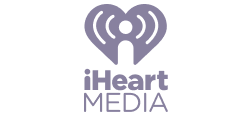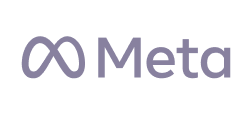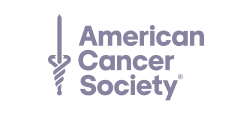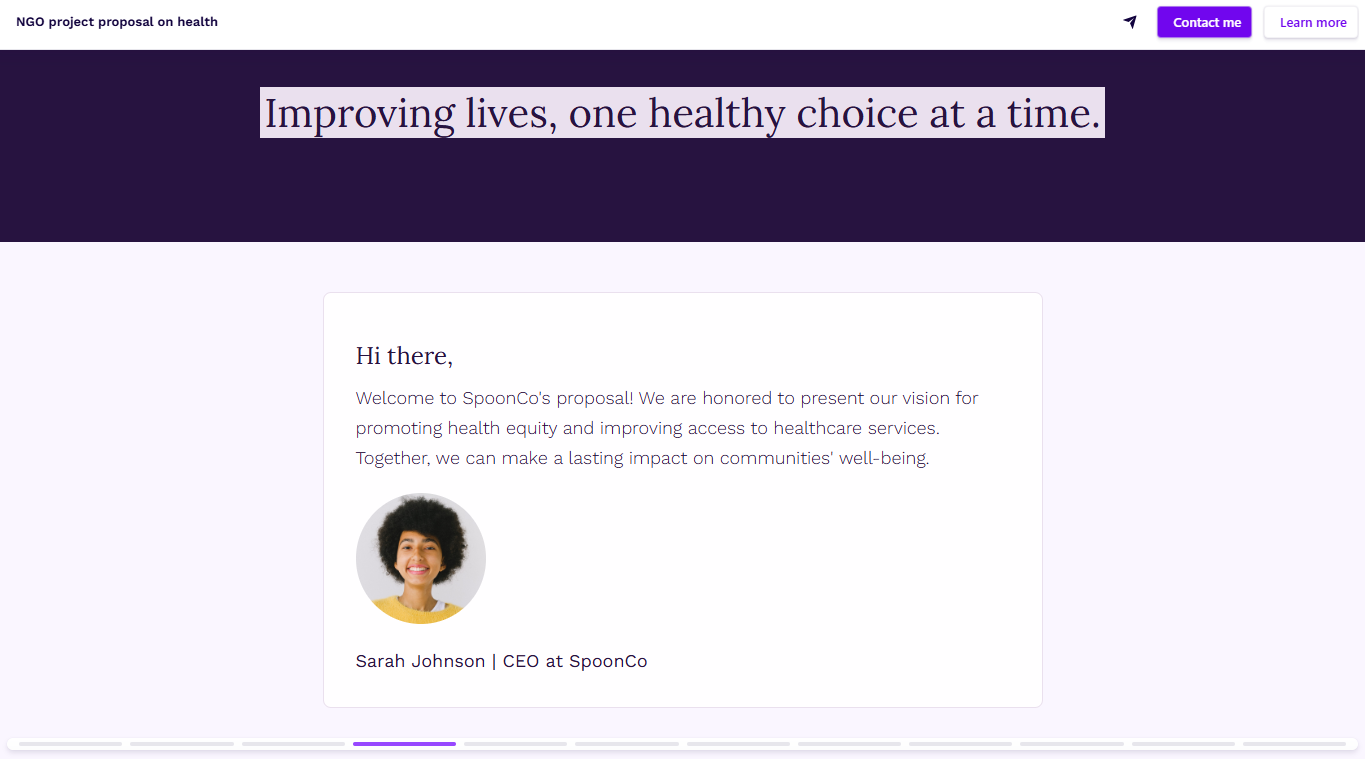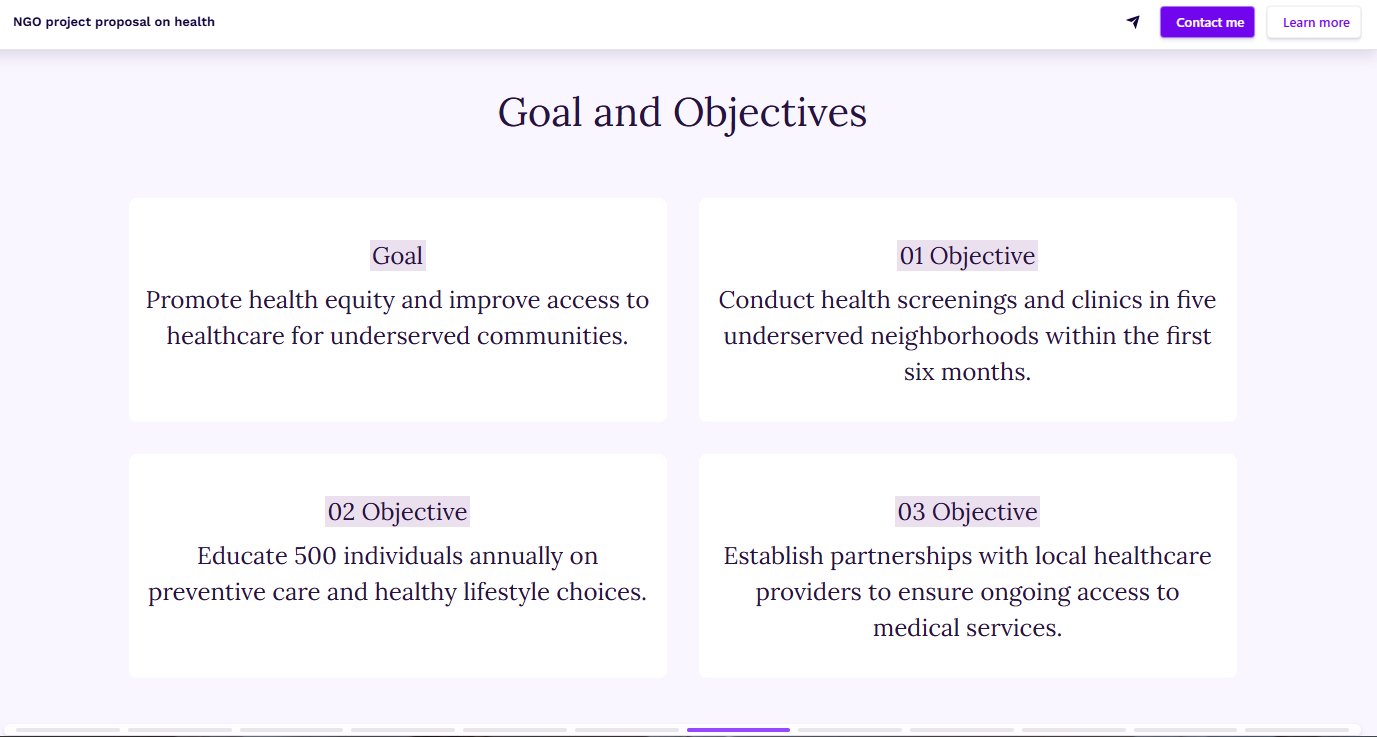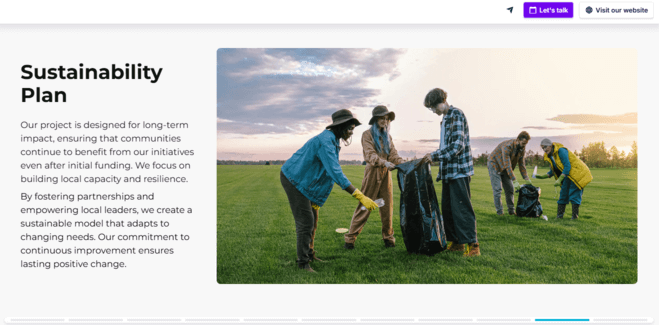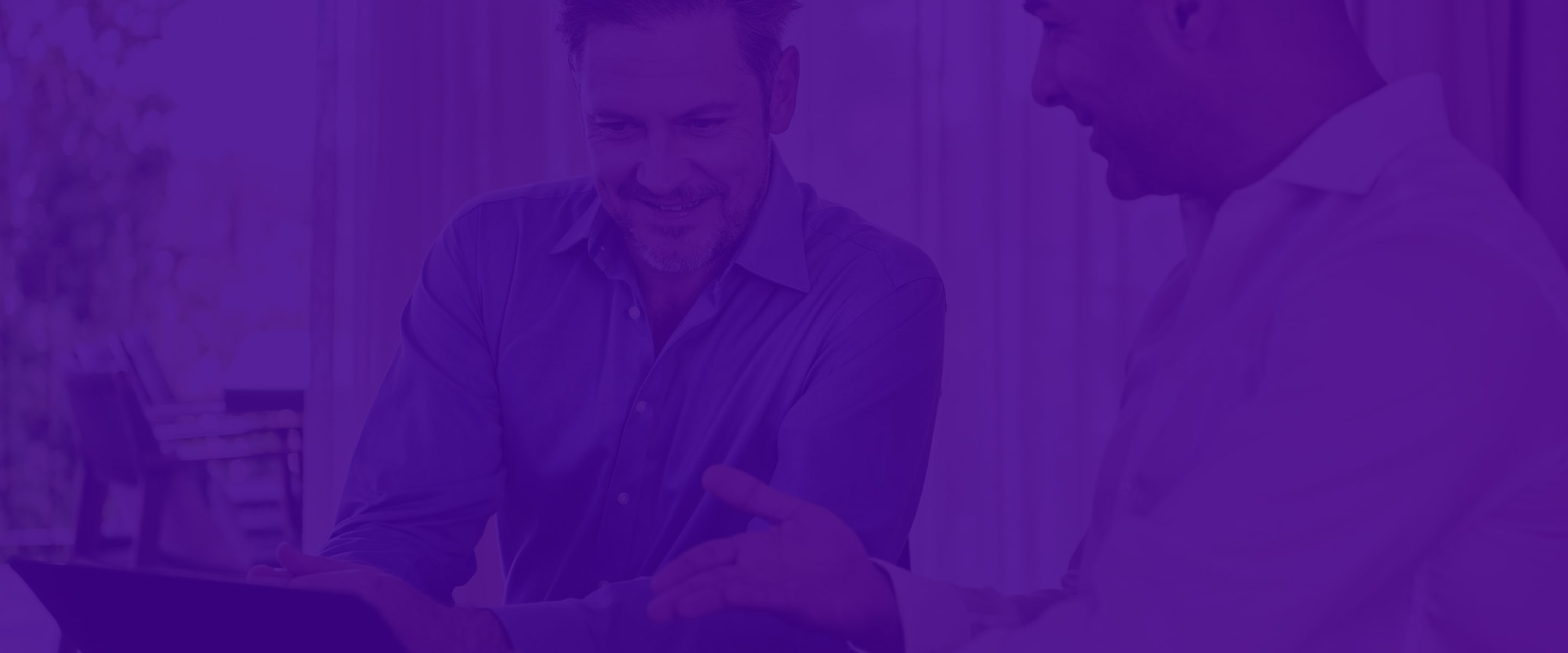How to Write an NGO Project Proposal (+Examples & Templates)
Learn how to write an NGO project proposal that stands out and gets funded. See winning NGO project proposal examples, instantly usable as templates.


Learn how to write an NGO project proposal that stands out and gets funded. See winning NGO project proposal examples, instantly usable as templates.
Short answer
Cover slide
Executive summary
Organizational background
Problem statement or needs assessment
Project goals and objectives
Project description and methodology
Monitoring and evaluation (M&E) plan
Budget and budget narrative
Sustainability plan
Risk analysis and mitigation plan (optional)
Annexes and supporting documents
Call to Action
Scroll down to read the full guide ⤵
What to include on your cover slide
Project title - Specific, outcome-focused, and free from buzzwords. Think: “Sustainable Water Access for 5,000 Households in Kivu Province”, not “Hydration for Change”.
Your organization’s name and logo - So reviewers can immediately see who the proposal is from - especially helpful if they're reading dozens in a row.
Date of submission - This matters more than you’d think, especially if there are multiple rounds or tight deadlines.
Reference number (if applicable) – If the donor included a code or call reference, it goes here. These are often used by reviewers or internal tracking systems - so if you leave it off, you risk getting misplaced or flagged as incomplete.
Donor or funding body - Helps signal that this proposal was written for them, not recycled from something else.
Key contact info - Name, role, email. Make it easy for them to reach out without digging through annexes.
💡 Pro tip: Before you write a single sentence, get familiar with the funder. What do they care about? What kinds of projects have they funded before? What language do they use to describe their priorities?
Your proposal should feel like it was written for them - because if it reads like a copy-paste job, you’re already at a disadvantage.
If they talk about “resilience” or “women’s economic empowerment,” and your project supports that? Say it, clearly. Make it easy for them to connect the dots between your work and their mission.
How to write an executive summary
Lead with the need - Set the context in one sentence. What’s happening? Why does it matter now?
State your goal - Be specific about the change you’re aiming for—not just the activity.
Explain your approach - What are you doing, how long will it take, and who’s delivering it?
Highlight the impact - How many people will benefit, and how will their lives be different?
Mention the budget - Show you’re cost-aware by stating the total ask upfront.
Write this section last - You’ll be in a much better position to sum things up once you’ve nailed down all the details. It’s easier to capture the full picture after the rest of the proposal is locked in.
Example:
In eastern DRC’s Kivu Province, more than 60% of households rely on unsafe water sources, leading to widespread illness and time lost collecting water. This project aims to provide reliable, clean water access to 5,000 households by building 15 community-managed water points over 18 months. Led by CleanFuture NGO, the project includes infrastructure development, community training, and post-construction support. The total funding requested is $380,000.
💡 Pro tip: Remember: you’re writing for more than one reader.
Your proposal might land on the desk of a field expert, a finance officer, a program manager, or someone from the board who barely skims. That’s why you need to strike a balance.
Present your approach clearly without watering it down. Avoid jargon - or explain it when it shows up for the first time. Keep your detailed methodology for the experts - but use your summary to hook the rest.
If different people all walk away thinking “This makes sense,” you’re doing it right.
What to include in the organizational background section
Who you are and what you do - A short, clear description of your organization’s mission and focus areas.
Relevant experience - Projects you’ve completed in the same region, sector, or with a similar scale or goal.
Your capacity - That includes technical expertise, financial systems, M&E processes, and staff.
Local credibility - Highlight community partnerships, past collaborations with government, or existing infrastructure.
Proof of success - Show the results of similar projects - like how many people you reached, what changed for them, and what’s still working today.
How to write a strong problem statement
Start with hard numbers - Quantify the problem using the best data you’ve got. “Only 40% of households have access to clean drinking water” is much stronger than “Many people lack safe water.”
Make it human - Who’s affected? How does this problem show up in their daily lives? Talk about the impact on women, children, or marginalized groups if relevant.
Explain why now - Spell out what’s at stake if nothing changes. Will illness rise? Will livelihoods shrink? Will more kids drop out of school?
Identify root causes - Go beyond the symptoms. What’s driving the issue? Is it geography, policy gaps, or infrastructure failures?
Position your project - Don’t promise to fix the whole system - focus on the specific gap your project can realistically fill, and make that the star of this section.
Back it all up - Use sources, citations, and footnotes. If a government study or health assessment supports your claims, use it.
Example of a problem statement:
In Kivu Province, over 60% of households rely on unprotected surface water for drinking, cooking, and washing - leading to high rates of waterborne illness, particularly among children under five. Childhood diarrhoea accounts for nearly 20% of under-5 deaths in the region. While some progress has been made in urban areas, rural communities remain largely excluded from basic WASH infrastructure. Women and girls are most affected, spending up to three hours a day collecting water, which limits school attendance and earning opportunities. Without targeted intervention, these conditions are expected to persist - and possibly worsen - as population pressure increases.
How to write strong, measurable goals and objectives
Start with one clear, overarching goal - This is the long-term change you're aiming for. Keep it short, outcome-focused, and avoid activity-based language.
Follow with SMART objectives - That means Specific, Measurable, Achievable, Relevant, and Time-bound. If a reviewer can’t picture what success looks like by reading them, they’re not clear enough.
Stick to 2–5 objectives - More than that, and it starts to feel bloated. Focus on what you can realistically track and deliver within the project period.
Keep outputs and outcomes separate - Outputs are what you do (e.g. "Train 30 water management committee members"). Outcomes are what changes (e.g. "Community-managed systems maintained with 90% uptime").
Example goal:
To improve access to clean and safe drinking water for 5,000 rural households in Kivu Province by 2026.
Example objectives:
Construct and operationalize 15 community-managed water points in five rural districts within 18 months.
Train 30 local water management committee members in maintenance and financial management.
Reduce reported cases of waterborne illnesses among target households by 30% within one year of implementation.
What to include in your project description and methodology
Activities - Break down the core interventions that will help you achieve your objectives. These should be clear, tangible, and well-sequenced. For example: “Construct 15 water points,” “Train 30 local committee members,” or “Deliver hygiene education to 500 households.”
Implementation methodology - Explain why you’ve chosen this approach. Are you using a particular model or community-led strategy? Did local partners help shape it? Will you be applying lessons learned from previous projects? If there’s anything technical or innovative here, this is where to mention it.
Timeline - Outline when each major activity will happen. This can be included here or as a separate slide. Either way, show that your plan is paced realistically.
Roles and responsibilities - Who’s doing what? Detail the project team, partner organizations, contractors, or government actors. Reviewers want to see that the right people are in place to do the work.
Target beneficiaries - Be specific. Who is this project for, and how will they be selected or involved? Explain how you’ll engage them, and whether you’ve already consulted them in designing the approach.
Location and context - Briefly describe where the work will take place, and any critical details reviewers should know about the setting - like access constraints, security issues, or relevant local dynamics.
What to include in your M&E section
Indicators - Use both output indicators (e.g. number of water points built, number of people trained) and outcome indicators (e.g. percentage reduction in diarrhoeal disease, increase in access to safe water).
Data collection methods - Describe how you’ll gather your data—baseline surveys, follow-up interviews, field logs, clinic records, etc. If you're using participatory methods or working in low-data contexts, explain your approach.
Schedule - Mention how often you’ll collect and review the data - monthly, quarterly, or at key milestones.
Responsibility - Specify who’s doing the monitoring and evaluation. Is it an M&E officer? Field staff? A partner organization? If there’s an external evaluator involved, say so.
Reporting and use of data - Let donors know how results will be shared and how they’ll inform future decisions.
Logical framework (if applicable) - Many international donors will expect a logframe - essentially a matrix that summarizes your goal, outcomes, outputs, and activities, alongside indicators, data sources (means of verification), and key assumptions.
Example indicators:
Output: 15 community-managed water points built and operational
Output: 30 water committee members trained
Outcome: 90% of target households gain access to safe water within 500m
Outcome: 30% decrease in reported cases of waterborne illness after 12 months
What to include in your budget section
Detailed line items - Break costs down into clear, logical categories: personnel, travel, materials, training, admin, monitoring, etc. Don’t lump everything under vague headers.
Justifications for key expenses - Use the narrative to explain anything that might seem unclear or unusually high. Why are travel costs what they are? Why is that consultant needed?
Alignment with activities - Reviewers will scan your budget to see if it matches your project description. If you're proposing 15 water points, the construction line should reflect that.
Cost-efficiency - You don’t have to be the cheapest—but you do need to look responsible. Show that you’re using donor money wisely without cutting corners.
Local contributions – If your organization or the community is contributing in-kind or financially, say so. It strengthens your case and shows buy-in.
Administrative or indirect costs - If you’re including overhead, make sure it follows donor guidelines. Some funders cap this (e.g. at 10–15%), others expect you to justify every bit.
What to include in your sustainability plan
Community ownership - Show how you’re involving beneficiaries from the start. If the community helped design the project or will be trained to maintain it, that’s a big plus.
Local capacity building - Explain how local staff, volunteers, or institutions will gain the skills to carry the work forward.
Partnerships and handover - Will the local government take over part of the project? Are you coordinating with health clinics, schools, or municipal services to integrate what you’ve built?
Financial sustainability - Is there a plan for covering future costs? Will there be income-generating components, user fees, local fundraising, or ongoing support from other sources?
Long-term support (if any) - If your NGO plans to stick around, say so - but explain how that support will look (e.g. periodic monitoring visits, refresher training, etc.).
Exit strategy - A clear plan for phasing out your involvement shows maturity. No funder wants to see you vanish overnight.
💡 Pro tip: “We’ll apply for more funding” is not a sustainability plan. Even if you do plan to apply again, show what happens if that funding doesn’t come through.
What to include in your risk and mitigation plan
The major risks - Pick 3–5 of the most relevant. These might include: security issues, political instability, supply chain disruptions, weather events, or community resistance.
How likely are they? - If helpful, use a simple “Low / Medium / High” risk level.
What’s the impact if it happens? - Will it cause delays? Interrupt delivery? Force a total redesign? Say what’s at stake.
What’s your backup plan? - This is the part funders care about most. How will you avoid the risk, minimize the damage, or adapt?
💡 Pro tip: Don’t list a risk if you have no way to mitigate it. Acknowledging it is good - leaving it hanging is not.
Examples of supporting documents to include
Organizational documents - Registration certificate, mission statement, financial statements, audit reports, board member list, etc.
Project-related documents - Maps, needs assessments, baseline data, technical schematics, Gantt chart, community consultation summaries.
M&E tools - Draft survey instruments, your logical framework (logframe), or logic model.
Letters of support - From community leaders, local government, partners, or stakeholders.
Staff CVs or bios - Especially for key personnel or technical leads.
Previous project summaries - To show credibility and track record.
Any donor-required forms - Some funders ask for special templates, checklists, or budget formats. Don’t skip these - they’re not optional.
Examples of clear, actionable CTAs
“Book a call with our team” - Even better if you embed a calendar link so they can do it in one click.
“Review the supporting documents in the annex”
“Visit our website for more information about our past work”
“Contact us directly for further documentation or references” - Offer help before they even have to ask.
Stop losing opportunities to ineffective presentations.
Your new amazing deck is one click away!

